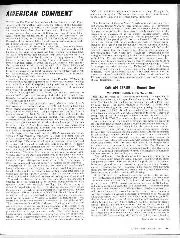
Can-Am series — round one
Mosport Park, Ont. (June 13th) The sixth season of J-Wax-sponsored Group 7 competition in America got under way at Mosport Park, Ontario, on Sunday, June 13th, with Team Gulf McLaren…
THE SCHNEIDER CUP SEA-PLANES.
WE recently had the pleasure of inspecting two of the machines which are among those from which the British team will be selected for the Schneider cup race at Venice on 25th September. They are the Supermarine S.5, and the Gloucester Bammel, which have recently been undergoing their tests at Calshot, Hampshire.
The Supermarine S.5, is a direct development from the S.4, model which was used last year, and is a monoplane with a Napier” Lion” engine. The machine gives one an amazing impression of compactness, and is one of the finest examples of steamlinMg we have ever seen. The three blocks of the broad-arrow 12-cylinder Napier are beautifully steamlined into the fuselage, the faring from the central block terminating in the inverted V-shaped windscreen in front of the pilot’s head. The petrol tank is in one of the floats, its weight being balanced by the torque of the propellor. The cooling water is carried in the planes, surface radiation being employed, and the oil tank is in the fuselage, the sides of which are ribbed for cooling. The machine is beautifully finished in blue and silver, and makes a very favourable impression. In contradistinction to the Supermarine, the Gloucester is a biplane, and also employs a Napier ” Lion” engine. The machine, if not quite so attractive as the “
5.5″ nevertheless gives an impression of great speed.
The lower of the planes, which are copsiderably staggered, is used for radiation for the cooling water, and, unlike the Supermarine, is ribbed. It is finished in silver and burnished copper. Two machines of this type, together with four supermarines will be sent to Venice, and the seventh English plane to go will be a” Crusader” fitted with a 9-cylinder Bristol ” Mercury” radial engine. This machine is a monoplane, but the radial engine presents serious difficulties in streamlining. Its diameter, however, is considerably less than that of the ‘Jupiter” from which it has been developed, and being air-cooled, gains considerably on the score of lightness. The machine which has been built by Short Brothers, has been undergoing its tests at Felixstowe, but it is not thought that it will prove as fast as the Gloucester or the Supermarine. Comparative tests after the machines arrive at Venice will decide which three will form the British team.
News for Raleigh Riders.
Riders of the well-known 498 c.c. Raleigh whose machines are fitted with the latest type of fork employing the single compression spring, will be interested to know that the type sent out as standard is supplied for either solo or sidecar purposes. Where a machine is used for solo work only, a lighter spring may be substituted with advantage. This spring can be supplied under reference number MS. 175c.